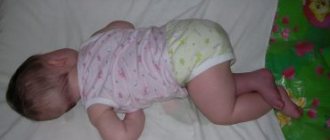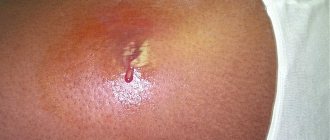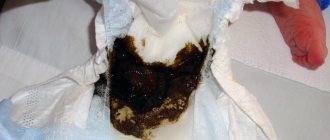After discharge from the maternity hospital, if they are not superstitious and do not plan to purchase everything they need only after the fact of birth. You need to remember to buy a lot: a bathtub, a changing table, a crib, diapers, bottles, a water thermometer, and a first aid kit. A heating pad for a newborn can rightfully be included in this list. Why is it needed, and what precautions should be taken?
It must immediately be said that an ordinary rubber heating pad that is filled with water poses a certain danger. To avoid injury to the child, you do not need to add too hot water to it; the temperature should be comfortable. You can't fill it to the brim; a small amount of water will suffice. Before placing it with the baby, you need to check whether the heating pad for a newborn is hermetically sealed and wrap it in thick fabric. Under no circumstances should electric models be used to warm the baby's feet - only to heat the crib.
Recently, various modifications of heating devices have been invented that do not pose any danger when used. A heating toy for newborns deserves special attention. Its price is approximately 600 rubles, a regular one will cost four times less. What is she like? This is a seemingly ordinary soft toy of a dog, duck or any other animal made from natural materials, filled with millet and lavender petals. It's easy to use: just heat it up in the microwave for a few minutes. After this, give it to the child or put it in the crib. This warm toy will remain this way for several hours, spreading a delicate lavender scent.
An excellent option for a newborn. It is also completely safe and made from non-toxic materials. The shell is a plastic bag of increased strength and tightness. Inside there is a special solution of salt, which is used in medicine. If used correctly, it cannot cause any harm to a person. On the contrary, this is a guarantee that there will be no overheating and burns.
Many mothers believe that such a salt heating pad for a newborn should be in every home. They are available in various forms and are intended for the treatment and prevention of a large number of diseases. They also perform the usual functions of keeping children warm while sleeping or walking outside. To start its operation, simply press the activator floating inside the solution and wait until salt crystals begin to spread from it in a wave. You will immediately feel warm. After a few minutes, the completely crystallized heating pad should be kneaded in your hands like dough and applied where needed. This baby heating pad (including for newborns) easily adapts to the contours of any part of the body. For a child under three years old, it is better to wrap it in cloth. And for the little ones, you need to maintain a distance of at least 5 cm from the body.
It has long been noticed that a baby’s colic goes away much faster if you warm his tummy. Before the invention of the heating pad, young mothers had to heat water and pour it into a container, make sure that it did not leak and was at the right temperature. Now life has been made easier by a salt heating pad; it can be found in any pharmacy.
All types of salt heating pads are self-heating, that is, they do not require external heating. There are two types of salt (salt) heating pad:
- disposable;
- reusable.
The disposable salt heating pad generates heat as a result of the reaction between its contents and oxygen and cannot be restored once the reaction is complete.
The second option is more economical for parents of a newborn, as it can be used repeatedly. This product is also called a thermochemical heating pad or simply a chemical heating pad. In addition to combating colic, this device can also warm the baby in a cold room or on a walk.
Benefits of a salt heating pad:
- produces dry, soft heat;
- heats up quickly;
- does not cause allergies;
- does not require any additional sources (socket - for an electric heating pad, water - for a regular heating pad);
- comfortable in any environment (both outdoors and indoors).
Salt heating pads come in the form of a mattress or funny figures. When warm, it takes the shape of the child's body. This format is very convenient to put in a crib or in an envelope for a baby without causing any inconvenience to him.
How does a salt heating pad work?
The principle of operation of a salt heating pad is to release heat when its liquid contents transform into crystalline form. Externally, it is a sealed volumetric container, inside of which there is a supersaturated solution of sodium acetate.
A saturated solution is very easy to unbalance, so any intervention, including simply pressing a special button inside, leads to the formation of a crystallization center. Excess sodium acetate crystallizes as a precipitate, releasing heat until the solution becomes saturated. Thanks to this type of heating of the heating pad, you can significantly save time if your child has colic.
How to restore a salt heating pad after use
Since this heating pad is considered reusable, after the next use its contents must be made liquid again. To do this, wrap the product in a cloth and leave it in a pan of boiling water for 15 minutes. The solution inside the heating pad becomes supersaturated again, the crystals dissolve, and the contents become liquid.
It is also worth remembering what not to do with a heating pad:
- do not heat in the microwave;
- when boiling in water, the heating pad must be wrapped in cloth so as not to damage its shell;
- Do not bend the heating pad while boiling, otherwise it may burst; it is better to boil each side alternately;
- do not pierce the material of the heating pad; if there are leaks, it should be thrown away;
- if the heating pad was in the freezer and has managed to crystallize, there is no need to boil it immediately - you should wait until the contents warm up to room temperature;
- You need to protect the heating pad from falls and impacts - it can self-crystallize.
Review of salt heating pads with photos
Today there is a huge range of salt heating pads that are used in different areas of life and for various purposes. Below is a list of the most popular products that are in greatest demand.
Warmer "Super ENT" for the nose
This is a reusable heating pad, which is designed specifically for the treatment of ENT diseases, including: sinusitis, frontal sinusitis, rhinitis, etc. Thanks to its convenient shape and light weight, which is 130 grams, it can be easily applied to the nose area, while the process of warming the sinuses will not cause any discomfort. To make the product, only environmentally friendly materials that are non-toxic are used. Inside, the heating pad contains a saline solution that is widely used in various areas of life. The heating temperature is 53 degrees, and this indicator can remain unchanged for 85 minutes.
"Insole" for feet
This is a special insole that is designed to be placed inside shoes for contact warming of the feet. This option is perfect for lovers of winter sports, including fishing, hunting, snowboarding, etc. The heating pad contains components such as water, activated carbon, salt, cellulose and iron, which makes the device completely non-toxic. The average temperature of the insole is approximately 35 degrees, while the maximum temperature is 39 degrees. The heat generated by the device is retained for five hours or more.
“Mattress” for the back and joints
This heating pad is a small plastic bag filled with a concentrated saline solution. Its dimensions are approximately 29 cm in length and 18 cm in width, which makes the heating tool a convenient device that is easy to use for household purposes. The maximum heating temperature of the heating pad is 55 degrees. To activate the process of salt crystallization with the release of heat, it is only necessary to slightly compress the spring immersed in the liquid. To use the tool again, it should be immersed in water and boiled for 20 minutes, after which the heating pad can return to performing its functions.
"Children's"
Baby heating pads are practically no different from classic salt heating pads. The principle of their operation is the process of salt crystallization, which makes the product completely environmentally friendly. Most often, children's heating pads have a shape and design that is interesting for children; they are often sold in the shape of cartoon characters or fairy tales. When heated, the solution reaches a temperature that is comfortable for the child’s body and cannot harm the child’s body. However, you should consult your pediatrician before using these heating pads.
"Mega" for hands
This type of heating pads is represented by a set of rectangular plates, which are individually packaged. The Mega Hand Warmer is an easy way to warm up frozen fingers during the cold season. In order to activate the heating pad, remove the protective film and paper from the plate, then fold the plate in half. Its operating principle is designed in such a way that the process of heat generation occurs only when a bend is formed. You can easily put it in a jacket pocket or tuck it inside a glove. The instrument heats up for quite a long time, more than eight hours, and its temperature is approximately 14 degrees.
How to use a salt heating pad with a button for newborns
If you use a heating pad to combat colic in a child under one year old, you need to follow a certain algorithm of actions:
- Press the applicator to start heating the heating pad.
- For children under 4 months of age, it is better to wrap the product in a thin towel.
- Lightly knead the hardened heating pad.
- When piercing, place a salt heating pad on the baby's tummy for 5 minutes.
When the colic subsides, the baby usually calms down and falls asleep.
There is no need to be afraid that the child will get burned by the heating pad, since it does not heat up to more than 54 degrees. This temperature is the most optimal and comfortable for a newborn. The heat is retained for several hours, depending on the size of the heating pad and the air temperature.
How can you use a salt heating pad?
This type of heating pad is multifunctional, as there are many different ways to use it on any part of the body. Today, various manufacturers produce products that have absolutely every possible shape and size. This allows everyone to choose the most suitable option for themselves. A salt heating pad can be used for the treatment and prevention of many different pathologies in children and adults.
Due to the fact that it becomes warm very quickly without additional heat sources, it can be used anywhere for therapeutic effects or simply to warm up the surface, for example, in the winter to heat a baby stroller, crib, sled or car seat. This is a fairly popular source of heat among fans of fishing, hunting, and tourists in winter. In such conditions, a self-heating heating pad is the most suitable option.
You can purchase the device both online and in medical equipment stores. Depending on the application methods, you can choose the appropriate form.
There are warmers in the shape of animals, hearts, snowflakes and other various shapes, as well as in the form of shoe insoles, collars, mattresses, face masks and so on.
Additional uses of a salt heating pad
A salt heating pad can be used not only for colic, but also for warming various organs - the throat, nose, and ears of babies. It is also effective for dysplasia. In addition, adults can also use this heating pad to relieve muscle tension or headaches (using a cold compress). The duration of use of a heating pad wrapped in a towel is 20 - 30 minutes. When the heating pad has cooled down a little, you can remove the towel and leave the product for another 10 - 15 minutes.
Salt heating pad mattress delta term how to use video
Salt heating pad - what is it?
A salt heating pad is a universal device that can be used to simplify the recovery process during a cold, eliminate pathologies of the nasopharynx and joint diseases. This excellent source of heat can replace such an unpleasant procedure as warming up with mustard plasters or cans.
Salt heating pads are a self-heating, reusable type of heating pad. The work is based on the effect of heat generation that occurs as a result of a change in the state of certain materials. Most often this is the crystallization of salts from a supersaturated solution. This kind of heating pads can be used not only for heating, but also for cooling.
This is a method of quickly obtaining heat at any time of the day. In order to warm up the heating pad, there is no need for additional heat sources, such as with a conventional water heating pad.
The salt heating pad can instantly heat up to a temperature of 52 degrees, while the heat is retained for quite a long time, on average about 2-3 hours. The duration of the thermal effect depends on the dimensions of the heating pad, its shape, and materials.
Why do you need to consult a doctor?
Of course, many ailments can be treated with heat, but in some cases, before purchasing a salt heating pad, it is better to consult a pediatrician. Thus, a heating pad should not be used by pregnant women, or if there is inflammation or wounds on the skin. In addition, the product is not recommended for infants who have pustules or ulcers on their bodies.
And even moreover, not all abdominal pain is a sign of colic. If the cause is more serious, different treatment will be needed. Only a doctor can prescribe it. He will also advise which heating pad model to choose if necessary.
What to do if the heating pad does not work
Sometimes parents are faced with the fact that the heating pad malfunctions. This manifests itself during boiling after use. Usually the contents become liquid. But there are cases when the liquid immediately crystallizes after boiling. First of all, it is recommended to check whether the button or valve of the heating pad is accidentally jammed.
If this is all right, it is advised to leave the salt heating pad in the water in which it was boiled until it cools completely. If this does not help, you should boil the heating pad again and repeat the procedure. It is not recommended to turn it on until it has completely cooled down.
In the home of a family that has a newborn, more and more items intended to care for the baby gradually appear. The first aid kit is replenished with children's medicines, enemas and gas tubes; on the shelves in the bathroom, mother's shower gels are replaced by shampoos and foams for the long-awaited child, and the usual washing powder is changed to hypoallergenic.
Another irreplaceable thing that you should get in advance is a heating pad for your newborn. Why is it necessary, and why do many parents consider it an indispensable assistant?
What are they needed for?
Heating pads have long been used as a reliable and simple remedy for getting rid of various types of diseases. Dry heat significantly increases the effectiveness of medications, eliminates muscle pain, improves blood circulation in heated tissues and speeds up metabolism. Heating pads are indispensable for relieving young children of pain caused by intestinal colic.
These products also fulfill their original function - they warm the human body. On a cold day, you can put a warm container in the stroller with your baby so that he does not get cold during the walk. Also, a heating pad for newborns can warm up the baby’s crib so that it is more comfortable for him to lie down in it after water procedures.
Kinds
Heating pads can vary in size and type.
There are small-sized products designed to affect certain areas of the body - sinuses, feet, abdomen. Large heating pads are designed to provide heat to large surfaces.
The type of heating pad can be water
,
electric
and
salt
. They also differ in appearance - in pharmacies and children's stores you can find quite original models. Thus, manufacturers of salt heating pads produce a wide range of children's products that look like a toy. Cute dogs, hippos and blots will not scare your baby at all, and the warming procedure will be very comfortable for him. Conservative water products have also changed their appearance in recent years, with some models looking like a knitted or plush toy.
Salt heating pad
A salt warmer is a sealed container with harmless chemical salts in the form of a solution. After pressing a button or switch, the product begins the process of crystallization of the contents and its heating. Gradually, the liquid solution turns into a solid state, while the salt heating pad heats up to a maximum of 54 degrees. This temperature will not cause harm to the newborn and, according to experts, is optimal for use by young children. The salt warmer cools down very slowly - about 3 hours.
During the heating process, the salt heating pad adapts to the shape of the part of the body with which it is in contact. If you place your child on the product, the baby will be very comfortable on it. A small children's heating toy will also flexibly change under the weight of the baby's limbs.
- when treating or warming children under 3 years of age, it is better to wrap the heated product in a towel;
- due to poor thermoregulation of newborn children, it is better to avoid close contact of their body with the heating pad; it is recommended to place the product at a distance from the baby’s skin;
- in order to provide the baby with warmth during a walk, place a thermal bag in the stroller at a distance of 15 cm from the newborn’s feet and cover the baby with a blanket;
- your baby may like a baby heating toy located near his tummy; examining it, he will be able to lie there for the sufficient time necessary to eliminate the pain from colic;
- to return the product to its original appearance, it must be boiled for 15 minutes, then removed and cooled;
- you can also use the product for cooling by placing it in the refrigerator for half an hour;
- Buy salt heating pads at a pharmacy, because only there you can purchase a certified product that has passed all the necessary tests and studies.
Electric heater
Electric heating pads are equipped with a thermostat, with which you can adjust the degree of heating, which is why many parents prefer such products over salt or water ones. Due to the fact that such a device requires an outlet, you will not be able to use it while walking. Plus, you'll almost certainly have to run extension cords to heat up your baby's crib before bed or the stroller before a walk.
- It is forbidden to use electrical products to heat the body of newborns, since babies do not yet function well enough; even by setting the thermostat to the lowest temperature, you can overheat the child;
- buy products only at the pharmacy;
- when choosing an electric heating pad, check the integrity of the seams and make sure that the product heats up evenly;
- Before use, be sure to make sure that when heated, the product does not begin to emit unpleasant odors.
Water heating pad
The rubber water heating pad has helped generations and is leak-proof, compact and easy to use. In addition, you can fill it with water at the temperature you need; it can both gently maintain heat and cool. The downside of this product is its strong heat transfer, which is why the liquid in the rubber container cools down quite quickly.
Recently, rubber heating pads have begun to be sold in beautiful knitted cases, and some models even look like a toy. Such “clothing” not only has an aesthetic function; the natural material eliminates skin contact with rubber that is unpleasant to the touch and helps retain heat in the vessel longer. In addition, a cute heating toy will not frighten the baby, but, on the contrary, will captivate him for the time necessary to achieve a therapeutic effect.
When you fill the container with hot water, be sure to check that the plug is securely attached; try pressing on the product, checking its tightness. If the baby heating pad has a cover, you need to remove it before pouring liquid into it, then wipe the rubber outside until dry and only then “put on” the product.
When using a rubber container to warm a newborn, do not lean it close to the baby’s skin, but keep it at a distance of 10-15 cm from him. Do not leave the baby alone next to a filled heating pad, especially if it looks like a toy, because if he gets carried away, he may accidentally touch the plug, water will spill out and burn the baby.
- It is better to buy heating pads at a pharmacy, where all products are certified;
- When purchasing, carefully check the integrity of the seams and surface;
- the product should not emit unpleasant odors;
- If possible, check the functionality of the salt or electric heating pad at the seller or at home immediately after purchase; the products should heat up evenly and not emit any sharp or unpleasant odors;
- When buying a children's salt heating pad, check the seams of the product for burrs; the toy should not scratch the child.
Dry heat, of course, has a very beneficial effect on our body, but this method of treatment should still be used with caution in relation to newborn children.
As already mentioned, thermoregulation in newborns functions very poorly. Wrapping yourself up with a blanket that is too warm can lead to overheating and an uncontrolled rise in the baby’s temperature, not to mention heating pads. Therefore, it is important to carefully approach the issue of using heating pads.
If you need to warm your baby, you should place the heating pad at his feet at a distance of 10-15 cm so that it evenly and gently gives him heat. It is important to be close to the newborn in order to remove the product immediately after the child is warm enough to prevent overheating.
Do not get carried away with self-medication, since abdominal pain can be symptoms of the onset of serious diseases, and heat exposure using a heating pad can only aggravate the situation, cause acute inflammation and lead to dire consequences.
Many parents use heating pads as a reliable remedy to help relieve pain from intestinal colic. Dry heat really quickly calms babies, but before using this method, be sure to consult with your pediatrician. The doctor will determine the nature of the pain in the newborn, and if the problem really is, he will recommend suitable products, temperature conditions and duration of procedures.
Despite the safety of salt heating pads declared by the manufacturers, do not give them to your child; this is not a toy, but a medicinal product, the place of which is in a home medicine cabinet.
A heating pad is a special device that applies dry heat to certain areas of the body. In the modern world it is used less and less, and in the arsenal of necessary means for a child it is not in the first place. However, this does not mean that you don’t have to have this accessory. No, this is an important thing, and you will now see for yourself.
A heating pad for a newborn against colic: which one to choose?
Colic is short attacks of acute pain. They are difficult to bear because they are repeated one after another and are intense. Infantile colic often occurs in newborns for reasons that are still unknown. A medical examination does not reveal any pathologies, and the baby, for no apparent reason, begins to scream, screams for a long time, and then suddenly, also for no reason and abruptly, calms down.
It is very difficult to endure the inconsolable shrill cry of a newborn. On parenting forums they give different advice: use “white noise” to calm, swaddle tightly, give a pacifier, the mother follow a special diet for breastfeeding.
Most often it is recommended to use a heating pad. But how justified is the use of this improvised remedy, and how can it help a newborn with colic?
Why does a newborn need a heating pad?
The heat exchange of newborns, like other body processes, is not yet perfect. The baby easily overheats or gets cold. And if the apartment is cold, then a warming vessel will improve your well-being and make your sleep deeper.
Many mothers are sure that warming procedures help the newborn cope with excessive gas formation and colic, and help them fall asleep faster.
Important! It must be remembered that thermal procedures in the tummy area are sometimes not only useless, but also dangerous to health. Therefore, only a doctor should allow you to apply a heating pad to your stomach.
How to choose a heating pad for babies
The principles of selection are universal for any product that the baby will use. They must be safe, harmless and not cause allergies. This means that you need to buy a certified product made from high-quality materials, without an unpleasant odor.
If we talk about heating devices, then one more point is added to the selection factors: tightness. It is unacceptable for hot contents to come into contact with delicate baby skin.
Types and principle of operation
All local heating devices vary in content. The heat source can be water, salt, gel, electricity and other, less common fillers, for example, cherry pits. Depending on the internal content, heat is released more intensely or softly, the device cools down more slowly or faster.
But the principle of operation is always the same. The dry heat generated affects a specific area of the body. Blood vessels dilate under the influence of heat, and then blood circulation in the organ located nearby is activated.
Which heating pad to choose
The most common types of heating pads used for colic:
- rubber, filled with water;
- saline;
- electric;
- with dry filler.
The method of use during colic, the advantages and disadvantages of each of them needs to be discussed in more detail.
Rubber
Hot water is poured into a rubber flat container and closed with a lid. Since rubber is not very comfortable for the skin, the device must additionally be wrapped in fabric, or you can buy a ready-made fabric case.
This is the cheapest and easiest to use variety. Among the disadvantages, mothers note: rapid loss of the desired temperature, the risk of burns when pouring water and the risk of leakage if used incorrectly.
Saline
It warms, but does not burn – this is the main characteristic of the salt structure. A salt heating pad for newborns helps against colic, as it gives off heat evenly and for a long time. The principle of operation is based on chemical reactions: the saline solution inside, when you press the switch button, begins to actively crystallize, releasing a high temperature.
The entire structure heats up to 54 degrees in 10-15 seconds, maintaining this value for up to one and a half hours. Gel heating pads work on a similar principle; they are also often recommended as a remedy for colic. Such devices heat up to almost 60% and maintain the temperature for about an hour.
Among the advantages noted by parents are:
- safety for a newborn, there is no danger of getting burned by boiling water as in the previous model;
- hypoallergenic;
- plastic design takes the shape of the body when used;
- to return to its original state you only need to boil for 10-15 minutes.
Electric
Thin thermal conductors are sewn into the natural fabric base. The device is connected to the mains and heats the entire time it is connected. It takes approximately 7 minutes to heat up. The temperature is controlled using a thermostat.
It is not recommended to apply the electrical structure to the body of a newborn. It is more suitable for warming a crib or stroller before placing the baby there.
With fillers
Mothers of newborns are very fond of modern eco-warmers with natural fillings. Along with salt ones, they are considered the most effective remedy for colic. To start using, a bag made of natural fabric is heated in the microwave. Soft heat transfer continues for several hours. Millet, buckwheat, lavender, and cherry pits are used as fillers.
Despite its completely natural ingredients and safety, this warming product also has disadvantages:
- the smell of the filler can have a calming effect, but for some children it will be an irritant;
- linen or cotton casing is not durable and cannot be washed.
How and when to use a heating pad for your baby
If the newborn is healthy, but screams for some unknown reason, then parents can use heat. However, you must be absolutely sure that the cause of the scream is colic, that is, spasms of unknown etiology, and not, say, inflammatory processes in the gastrointestinal tract.
Excessive heating at elevated body temperatures is contraindicated, since the inflammatory process is already quite active.
You should also not use external heating too often, because then the newborn’s body will not learn to independently regulate the temperature and the baby will be sensitive to minimal cooling.
You should not resort to thermal procedures for any types of skin damage or irritation.
Application depending on type
Regardless of the principle of operation, the device should not be applied directly to the skin of a newborn. The body is isolated from the heating pad using a folded diaper or other fabric.
- Salt structures get quite hot, so wrap them in a layer of fabric no thinner than 5 mm. Turn on the device by pressing the special switch button inside the liquid solution. After this, the solution will quickly harden and begin to give off heat. To return the filler to its original liquid state, the device is boiled for about 15 minutes. And if you place the salt heating pad in the refrigerator for 20-30 minutes, then it can be used for cooling.
- A heating pad is used to warm a crib, stroller, or towel, but is not applied directly to the newborn during colic.
- Eco-warmers with fillings are heated in the microwave, oven, or even on a hot radiator. When using an eco-heating pad, the risk of burns is minimal. Often such designs are equipped with ribbons to comfortably secure a warm pad on the baby’s tummy during colic.
- A rubber heating pad is used like this: fill the container two-thirds with water, carefully squeeze out excess air, and screw it on. Then they turn it over and check whether water is leaking, wrap it in cloth and place it next to the baby.
Anti-colic heating pad for newborns: reviews
Many mothers note that applying a warm cloth to the tummy calms the baby, relieves tension during colic and constipation in infants. Of course, it is more convenient not to constantly heat the diapers with an iron, but to use heating pads with various fillings. After all, they keep warm longer than diapers, and they are very easy to use.
- For example, Marina writes that she bought the simplest device in the form of a fabric animal with a rubber reservoir inside. It’s convenient that the container hidden inside did not need to be additionally wrapped in a towel. All you had to do was fill it with hot water and apply it.
- Iliana thinks the best anti-colic heating pad for a newborn should be filled with barley husks. It was this kind of thing, according to Iliana’s observations, that eased her baby’s spasms and helped him fall asleep peacefully.
- Olya praises cherry pits as a filler. It is especially convenient that there is practically no hassle with heating: heat it in the microwave and you’re done! The heat lasts a long time, but does not burn.
- But Alena sewed a bag with cherry pits herself. The woman warmed it in the microwave and put it on her baby’s tummy when she had colic. Alena cannot say with certainty that it was the warmth of the cherry pits that had a beneficial effect, but she did not stop putting them on the child’s belly, since the child certainly did not get any worse. But here you need to remember a serious warning: warmth will be beneficial if, apart from screaming, there are no other alarming symptoms. And if, for example, spasms are accompanied by foamy stool in a baby, or other symptoms of a health disorder, then warm compresses in the abdominal area can only do harm.
- Yulia believes that no medications help with spasms, and the loud cry of a newborn just needs to be endured. However, the woman admits that the salt heating pad sometimes helped their family out - their daughter quickly calmed down and fell asleep.
How to reduce colic: video
At Dr. Komarovsky's school, they examine different versions of the occurrence and methods of treating infantile spasms.
Although the causes of colic have not yet been clarified, the consolation is that attacks of inexplicable crying go away with age: by 4-6 months of life. For parents, the main thing is to be patient, do everything possible to alleviate the baby’s condition, and not be upset. If you have a particularly successful method for dealing with colic, please share it with other readers. And may your baby’s childhood be easy and prosperous.
Source: //okrohe.com/deti/meditsinskie-preparaty/grelka-ot-kolikov-dlya-novorozhdennogo-kak-ispolzovat.html
Why does a newborn need a heating pad?
For warmth and better sleep
It is a well-known fact that newly born babies are not “tuned” to heat exchange; there is no thermoregulation as such yet. Therefore, they are easy to overheat or, conversely, “freeze”. And of course, no one wants a child to freeze and catch a cold! But the situations are different: it’s cold in the apartment, there’s no way to sleep with the baby and warm him with your body. In this case, a heating pad for newborns can really help. Place it in your baby's crib or cradle, and he will feel better and sleep longer.
During walks in the cold season, you can also create proper comfort for your baby by placing a heating pad in the stroller.
To minimize pain from colic
Colic is the most common problem in newborns. Pediatricians often differ in their opinions about the means to help cope with it. Some prescribe specialized medications from the pharmacy to drink, while others, when colic occurs, advise parents to put “something warm” on the tummy, for example, a heating pad or a diaper ironed with a hot iron. A good pharmaceutical product is expensive, and before you focus on it, try a heating pad. As the experience of mothers, which they write about on numerous forums, shows, heating pads - all different - are a real salvation for a child.
For illnesses
For some types of diseases, a heating pad helps reduce pain, soothes and relaxes. Important: if you are sick, you should not do any thermal procedures without the recommendation and supervision of a doctor!
V. Algorithm for performing a simple medical service.
Preparation for the procedure:
- Introduce yourself to your mother, explain the purpose and course of the upcoming procedure, and obtain informed consent for it.
- Treat your hands hygienically and dry them.
- Fill the heating pad to 3/4 of its volume so that it does not press with its weight, the water temperature is 60C.
- Release the air by pressing, tighten the cap well, tilt the heating pad with the cap down, and check for leaks.
- Wipe the heating pad dry.
- Prepare 2 more hot water bottles in the same way.
- Wrap the heating pads in diapers.
- Put the baby in the crib.
Performing the procedure:
- When warming a premature baby using rubber heating pads, three heating pads are used, which are placed between layers of blankets, as a rule: one of them is placed under the baby’s feet, and the other two are placed along the body on each side (at a distance of about 10 cm from the baby).
- Change the heating pads as they cool down. You cannot replace the water in all heating pads at the same time - in order not to overcool the child, they do this one by one.
- Cover the child with a blanket.
- When completing the procedure, pour the water out of the heating pads and treat their outer surface with disinfectant. solution.
- Treat your hands hygienically and dry them.
- Make a record of the manipulation in the medical documentation.
When is it possible and when not to use a heating pad?
This question is perhaps the most important and should be asked first. The main rules to remember:
For acute respiratory viral infections and acute respiratory infections, a heating pad should never be used in the acute stage of the disease, when the child has a fever and poor general condition. Any thermal effects at this moment are CONTRAINDICATED, as they will trigger an already active inflammatory process. Thermal procedures are effective and beneficial only when the disease recedes. By applying a heating pad to the source of inflammation, you will speed up the baby’s recovery, as you will start blood circulation in a specific organ or tissue.
For abdominal pain: with any purulent-inflammatory processes in the intestines (for example, with appendicitis), a heating pad can lead to rupture of the inflamed appendix and peritonitis. Until you know why your baby’s tummy hurts (is it really colic or something else?), it’s better to hold off on using this remedy. ONLY A DOCTOR CAN PRESCRIBE A HEATING HEATING RATING FOR THE ABDOMEN!
Anti-colic heating pad for newborns: does it help or not?
Many young parents have to deal with the problem of colic in their infants. Most often, this phenomenon is observed in babies under 3 months of age, as the newborn’s digestive system adapts to new foods and new circumstances.
How effective is a heating pad for colic? What types of heating pads are there, and how to use them?
A complex approach
Breastfeeding and the correct diet of the nursing mother, special gymnastic exercises and massage, placing the baby on the stomach, drinking dill water and other means will help prevent the occurrence of such a problem.
In addition, heat exposure will help cope with intestinal colic. To do this, you can simply stroke the baby’s tummy with a warm palm, place the baby on the mother’s stomach, or apply a warm diaper, pre-heated with an iron.
This technique has been used for many years, it is quite effective, but there is one drawback - the diaper becomes cold pretty soon. In order to maintain the required temperature for a certain time, a special heating pad for a newborn against colic has been developed.
Let's get acquainted with the types of this device and the rules of use.
What is colic and its signs
Colic is a fairly common condition in newborns under 3 months of age. This phenomenon is accompanied by painful manifestations in the tummy, increased gas formation, restless behavior and crying. Experts believe that colic is accompanied by the child’s digestive system getting used to eating new foods and to a new situation.
Currently, there is an opinion that the appearance of colic indicates nervous tension (“birth stress”) experienced by the baby in the process of adapting to life outside the mother’s abdomen.
Colic is determined by the following signs:
- the baby lies with his legs tucked to his tummy;
- restless, whiny behavior (especially after eating);
- sometimes refuses to eat;
- possible change in stool;
- sleep dysfunction due to spasm and pain.
Colic is a temporary condition. The duration of this phenomenon is approximately 2 months. Although every parent, having noticed the torment of their child from pain, wants to eliminate the problem in any way. For this reason, almost everyone tries to buy a heating pad and wonders: will it help the child?
What is a colic heating pad?
The purpose of the device is to warm the pathological area, or the entire body.
A heating pad for a newborn has a therapeutic effect by dilating blood vessels and accelerating blood circulation. This helps eliminate spasms and reduce pain.
The device can be attached to the child (if provided) or placed next to him in a crib or stroller.
But such a device is not a universal remedy. For one child, a heating pad will help eliminate colic, but for another, this method will be ineffective. Of course, a heating pad can calm you down, since children always like soft and warm things.
To cope with colic, a special device is not at all necessary; many consider it an unnecessary, expensive thing. Parents must decide what exactly to use to eliminate such a problem - a heating pad or other more accessible methods.
Types of heating pads
There are several types of warming devices that are used to relieve colic.
You can buy a heating pad in pharmacies and specialized children's stores:
- rubber (filled with water);
- saline;
- electrical;
- with dry filler.
Let's take a closer look at each type of device.
With dry filler
This device has recently become increasingly popular. Like salt heating pads, a device with a natural filler is considered the most effective method of eliminating colic.
Before use, the bag made of natural material is heated using a microwave oven. The heating pad can gently release heat for several hours. The bags are filled with millet, buckwheat, lavender, and cherry pits.
Although such a warming device is absolutely natural and harmless, it has some disadvantages:
- For some children, the aroma of fillers will have a calming effect, while for others it will cause irritation;
- The fabric from which the bag is made is short-lived and cannot be washed.
Use depending on variety
Regardless of how the device operates, it is prohibited to apply it to the baby’s uncovered skin. You must first place a folded diaper or other cloth on the body.
Rules of application:
- The heating of the salt heating pad occurs quite strongly, for this reason it must be wrapped in a cloth with a layer of at least 5 mm. The device is then turned on by pressing a switch in the liquid solution. After switching on, the saline solution quickly becomes solid and heat begins to be released. To return the filler to its original liquid form, the device must be boiled for 15 minutes. And by placing the salt device in the refrigerator for about half an hour, you can use it for cooling.
- An electric heating pad is a good device for heating a crib, stroller, or towel. But it is not recommended to use such a device to apply to the body of a baby with colic.
- pad with dry filling must be preheated using a microwave, oven or battery. When using eco-heaters, the risk of getting burned is minimal. Typically, such a design is equipped with ribbons for conveniently securing a warm pad on the stomach of a child with colic.
- The rubber heating pad is filled 2/3 of the volume with water, then you need to carefully squeeze out the remaining air and screw on the lid. Then the device must be turned over and checked to see if liquid is leaking out. The heating pad should be wrapped in cloth and placed near the newborn.
In what cases is it contraindicated to use a heating pad to relieve colic?
A heating pad for newborns against colic has some contraindications for use.
It is not recommended to use such a device if you have:
- inflammatory process in the peritoneal organs, problems with the stomach and intestines;
- rashes, hyperemia on the tummy;
- any acute pathologies, including ARV and ARVI of the acute stage;
- injuries or wounds in the baby.
Bottom line
To date, the factors that provoke the occurrence of colic have not been fully studied. The good news is that this phenomenon will cease to bother you over time.
Parents simply need to be patient and, if possible, alleviate the baby’s condition.
Source: //its-kids.ru/grelka-ot-kolikov-dlya-novorozhdennyh.html
Types of heating pads
The most common:
- water,
- saline,
- electric,
- with filler.
Let's look at each one separately.
Water (rubber)
Today, rubber heating pads are called “grandmother’s appliances.” They have been tested by time (and of course, by grandmothers). This heating pad is a rubber container into which hot water is poured. It has its pros and cons.
The rubber (water) heating pad is time-tested. Hot water is poured into the container, and the device is ready for use!
Pros:
- cheap;
- easy to use (as the advertisement says: “Just pour water”).
Minuses:
- pouring water into a container can cause you to get burned;
- poor control over water temperature (if you don’t calculate it, you can burn your child);
- cools down quickly;
- to feel the thermal effect, you literally need to lie on it;
- short service life (with frequent use it will crack).
Features of using a water heating pad:
- Fill it 2/3 with water.
- There is air in the upper part, the heating pad needs to be squeezed to “expel” it. And only after this can you screw on the lid. If the air is not removed, the heating pad will be “inflated” and it will be uncomfortable for the baby to lie with it.
- Once the lid is closed, it is very important to turn the heating pad upside down and make sure that nothing leaks out of it. The most unpleasant thing that can happen when using a rubber heater is a burn from hot water.
- We wrap the device in a towel or diaper (or a special knitted “blouse”).
Saline (chemical)
The most beneficial heat is considered to be that which is hot but not scalding. But most importantly, it must be obtained from a source that gives off heat evenly and cools for a long time. These are the properties that a salt heating pad has.
It consists of sealed containers made of strong PVC, which are filled with saline solution (sodium acetate). To start the heating process, you need to press the catalyst in the form of a spring or button that floats inside. The liquid salt solution will begin to actively crystallize and heat up literally before our eyes to 54°C (in 10-15 seconds). This is the optimal maximum temperature from a physiological point of view.
The salt heating pad has almost no disadvantages, is absolutely safe for a newborn, and is easy to use.
Pros:
- hypoallergenic;
- safe for newborns, as it is sealed and contains a non-toxic salt solution inside;
- when applied, takes the shape of the body;
- This is a reusable product: to return it to its previous initial state, you need to boil the device for about ten minutes. It can be used up to 1000 times.
Minuses:
- It’s hard to call it a minus, but still: heat retention is not very long - about an hour and a half.
This type of heater has almost no disadvantages, so a salt one is the best heating pad for a newborn.
Electric
It is made from natural fabrics into which heat conductors are sewn. Requires an electrical connection. Just 220 volts, and dry heat will be with you as much as your heart desires! Most importantly, before purchasing, do not forget to check the presence of a temperature regulator (thermostat). Without it, you can get burned.
An electric heating pad is a good modern option, but it is somewhat inferior to other types of heating pads, mainly due to the lack of autonomy.
Pros:
- Using a thermostat, it is convenient to regulate the temperature;
- If electricity is available, heat will be retained as long as necessary.
Minuses:
- electric heating pads do not heat up immediately, but within 5-7 minutes;
- the fact that they work from the network is also a disadvantage, because you cannot take such a heating pad with you for a walk;
- high price.
With filler
The peculiarity of these devices is that inside they do not have a chemical heater, like their salt counterparts, but a natural one, in the form of various fillers - cherry pits, selected millet, lavender, buckwheat granules, gel (peat gel). The natural shell made of linen or cotton is also pleasing.
In order to heat the heating pad, you need to put it in the microwave for a few minutes. It will be warm for several hours.
A heating pad with filling is convenient to use, it is safe, and is made from natural materials. But there is a minus - fragility.
Pros:
- easy to use;
- completely natural;
- safe for the child (natural fillers will not burn the baby, even if the heating pad breaks;
- lavender filler smells pleasant and has a relaxing effect, useful before bed;
- a baby heating pad can be in the form of a toy or pillow.
Minuses:
- the smell can also be a disadvantage, as it will irritate the child, and he, on the contrary, will not be able to fall asleep;
- the shell is short-lived and fragile;
- The heating pad cannot be washed; it must be treated only by dry cleaning.
USING HEATING PADS TO WARM A NEWBORN
Indications : warming sick and premature babies, resorption of an inflammatory focus, spastic pain in chronic diseases of the digestive system.
Contraindications : acute inflammatory processes in the abdominal cavity, tumors, bleeding, increased body temperature.
Preparation of m/s: wash hands with running water and soap, dry.
Equipment:
rubber heating pad, hot water, water thermometer, diapers.
Execution algorithm :
1. Fill the heating pad with hot water 45˚ C to 2/3 of the volume.
2. Release the air by pressing the heating pad until water appears from the neck.
3. Tighten the plug, check the tightness of the heating pad (lower the shutter down).
4. Wrap the heating pad in a diaper.
5. To warm the newborn, use three heating pads, which are placed on top of the blanket. One heating pad is placed under the child’s feet, the other two along the body on each side.
6. Change the water one at a time, with an interval of one hour.
7. Periodically measure body temperature.
Manipulation No. 14
PREPARING MOTHER AND BABY FOR BREASTFEEDING
Indications : no contraindications from mother and child.
Contraindications : severe severity of the condition, choking, turning blue, respiratory arrest, coughing during feeding.
Preparation of m/s: wash hands with running water and soap, dry.
Equipment:
in the first days after childbirth, the mother feeds the baby in bed, lying on her side, then sitting on a chair, placing her foot on a low bench.
Execution algorithm :
1. The mother washes her hands clean.
2. Before feeding, the baby is swaddled.
3. The baby’s head is placed on the forearm so that it is convenient to grasp the nipple with the mouth.
4. The mother slightly lifts the breast with her hand, holding it between 1 and the other fingers, and places the nipple in the baby’s mouth so that he grasps it well with part of the adjacent skin.
5. Breastfeeding should last no more than 20 minutes.
6. After feeding, you need to express the rest of the milk and dry the mammary gland with a napkin.
7. Each subsequent feeding is given to a different breast.
Manipulation No. 15
HOLE FEEDING
Indications : mixed and artificial feeding.
Contraindications : absence of sucking and swallowing reflexes, choking, turning blue, respiratory arrest, coughing during feeding.
Preparation of m/s: wash hands with running water and soap, dry.
Equipment:
sterile bottles, sterile nipples, a bottle of milk, a container of warm water for heating milk, a water thermometer.
algorithm :
1. Place the bottle of milk in water heated to 40-45˚C. Monitor the temperature using a thermometer (milk temperature 37.0-37.5 ˚ C).
2. Prepare a separate sterile bottle and pacifier for each child.
3. The hole in the nipple should be small so that the milk flows out in small drops.
4. During feeding, the bottle should be held so that the neck of the bottle is completely filled with milk.
5. After finishing feeding, clean the lips and cheeks with a clean napkin moistened with boiled water.
Manipulation No. 16
CONTROL FEEDING
Indications : determination of the amount of milk sucked from the breast during one feeding.
Preparation of m/s: wash hands with running water and soap, dry.
Equipment:
table, cup scales (electronic), rags, marked container with 1% chloramine solution - for clean rags, marked container with 1% chloramine solution - for dirty rags, diapers.
Execution algorithm :
1. Treat the scales with a disinfectant solution.
2. Adjust the scales.
3. Swap the baby.
4. Weigh the baby in diapers on a cup scale.
5. Give the baby to the mother for breastfeeding.
6. After feeding, weigh the baby on a scale without changing diapers.
7. The difference between the first and second weighing will show the amount of milk sucked.
Manipulation No. 17
CLEANING BOTTLES AND NIPPLES AFTER FEEDING
Indications
:
maintaining sterility.
NEAT TREATMENT
Equipment
:
marked dishes for clean and dirty nipples, sterile tweezers, boiling dishes, sodium bicarbonate.
Execution algorithm:
1. Rinse dirty nipples in running water, then with warm water and soda (0.5 teaspoon of sodium bicarbonate per 1 glass of water), turn them inside out.
2. Boil in a special container in 2% soda solution for 15 minutes.
3. Drain and store in a sealed container labeled “Clean nipples.”
4. Remove with sterile tweezers.
BOTTLE PROCESSING
Equipment
:
mustard, brush, dry-heat cabinet, sterile cotton-gauze swabs, bottle storage cabinet, boiling utensils
Execution algorithm:
1. Degrease bottles in hot water with mustard (50 g of powder per 10 liters of water).
2. Rinse with a brush from the inside, rinse the outside, rinse.
3. Place neck down in metal mesh.
4. After the water has drained, place in a dry-heat oven for 60 minutes. at t 180° C.
Manipulation No. 18
Basic selection principles
- Safety.
- Tightness.
- Harmlessness: the material must be of high quality and natural; There should be no unpleasant odors.
- Hypoallergenic: none of the components of the heating accessory should cause allergies in the baby.
- The product must be certified.
It is better to purchase this accessory at a pharmacy or specialty store. Only there are all the above basic principles of choice observed.
Remember that no matter what kind of heating pad you “warm up” at your side, doctors do not advise abusing such pleasure. Otherwise, the baby’s skin will become sensitive to the slightest cooling. To avoid drying out the baby's delicate skin, apply moisturizing milk or baby cream to it before warming it up.
Here's another important tip: you should not apply a heating accessory directly to the baby's skin.
Wrap it in a towel or diaper. And if the heater is intended for a newborn, then there should be at least 5 cm of tissue barrier between it and the baby’s body.
We all want our children to be healthy, and sometimes it is psychologically important for us to “do something” when the baby is in pain or ill. But don't be overzealous. Extra thoughtless movements can only do harm! A heating pad can either help or aggravate the problem, so you need to approach everything wisely, and preferably “with the mind” of a doctor.
Colic is a physiological process that occurs due to the accumulation of gas bubbles in the intestines. For a newborn, this is quite unpleasant, but, in general, almost all parents encounter this. The condition immediately frightens the child’s mother, especially if she is inexperienced. Symptoms of colic are as follows:
- the baby is restless, lethargic;
- cries often, cannot sleep;
- restless sleep, the child twitches in pain and groans.
But the first symptom of colic is a cry that has no reason. Towards evening, the baby becomes restless, his face turns red, the abdominal muscles are tense and can be easily palpated with the hand. The baby may knock his legs; after defecation or the release of gases, he calms down. At first, the attacks are not frequent, but if the problem is not addressed, they will become a nightmare for the baby and his parents.
Colic can be either physiological or symptomatic. They often indicate the development of pathologies such as Crohn's disease, lactose intolerance, intestinal infections, etc. That is why it is necessary to see a doctor and conduct an examination.
The first point of treatment for colic will be to change the diet of the nursing mother, since the gastrointestinal tract of the baby depends on the composition of the milk. The main product that mothers should ration is cow's milk. Almost everyone is lactose intolerant to some degree. Therefore, a good solution would be to reduce its intake by replacing it with fermented milk products. Black bread, even in adults, causes flatulence and gastrointestinal disorders, as a result of which it is also recommended to exclude it or reduce the amount of consumption.
Buckwheat can cause disturbances in the gastrointestinal tract. It is very useful for both mother and child, but it is better to remove it from the diet during colic. Legumes are also very beneficial for the body, but they cause severe flatulence, so it is recommended to exclude them too, replacing them with soy cheese if desired. It is useful and does not cause changes in the gastrointestinal tract. At the same time, it stabilizes the baby’s metabolism.
Pickled vegetables should be completely removed from the diet, since if the baby has colic, they will only cause harm. Sodas, juices, Jerusalem artichokes, radishes, turnips, onions, artichokes, and mushrooms are excluded, as they all have a strong effect on milk and, as a result, on the baby, causing flatulence and colic.










